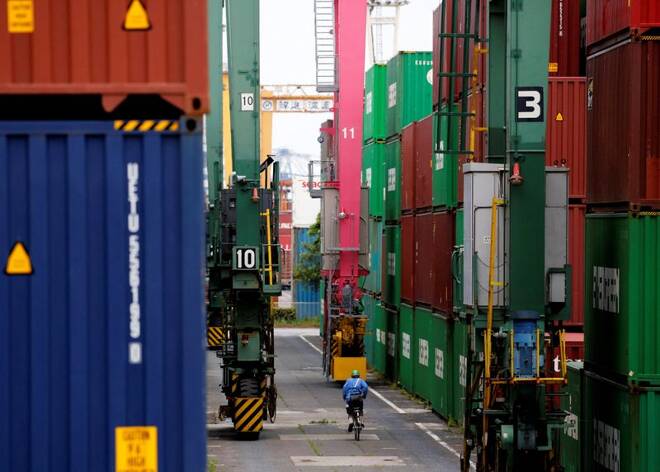Advertisement
Advertisement
Japan’s exports pick up on improved autos output, imports hit record
By:
TOKYO (Reuters) - Japan's exports rose 20.5% in November from a year earlier, the Ministry of Finance (MOF) data showed on Thursday.
By Kantaro Komiya
TOKYO (Reuters) -Japan’s exports sped up in November, as supply constraints eased slightly for the country’s big automakers, although imports hit a record on soaring materials costs, which could hurt household consumption.
The trade data came days after the Bank of Japan’s quarterly tankan survey showed an improvement in service-sector sentiment, suggesting robust consumption will support the recovery, although the new Omicron variant and rising costs remain downside risks.
Exports climbed 20.5% in November from a year earlier, government data showed on Thursday, the ninth straight month of increase, slightly missing forecasts for a 21.2% gain but well up on a 9.4% rise in the previous month.
Shipments of cars – Japan’s No.1 export item – rose 4.1% from a year earlier, marking the first increase in three months, although auto exports to the United States and China decreased year-on-year.
“The jump in exports in November suggests that most supply chain constraints in the automobile sector had already eased last month,” said Tom Learmouth, Japan economist at Capital Economics.
“Exports will remain strong over the coming months as motor vehicle exports recover further and external demand for capital goods continues to rise.”
Other than cars, growing shipments of steel, semiconductor equipment and chips contributed the most to the increase, a government official said.
Shipments to China, Japan’s biggest trade partner, increased 16.0% year-on-year, the data showed.
Imports rose 43.8% year-on-year in November to 8.32 trillion yen ($72.87 billion), the largest yen amount since comparable data became available in January 1979 and jacked up by a 144.1% rise in fuels such as oil, LNG and coal.
Imports growth accelerated from 26.7% in October and was bigger than economists’ forecast of 40.0%.
That brought a trade deficit of 954.8 billion yen, the biggest shortfall since January 2020 and exceeding the median estimate for a 675.0 billion yen deficit.
“While the weak yen has certain benefits such as boosting exporters’ competitiveness and inbound tourists’ spending, more Japanese manufacturers have shifted production bases offshore and COVID-19 border controls shut out tourists now,” said Masato Koike, senior economist at Dai-ichi Life Research Institute.
“Rising costs are weighing on Japan when a weak yen has less impact on increasing sales of goods and services.”
The BOJ’s latest tankan survey on Monday showed rising raw material costs clouding the corporate and economic outlook. BOJ governor Haruhiko Kuroda said on Wednesday inflation may approach its elusive 2% target.
However, the central bank is unlikely to change its easy monetary policy at its next rate review on Friday.
The world’s third-largest economy is expected to post strong growth in October-December after a contraction in the third quarter, as household spending improved on low COVID-19 infections.
($1 = 114.1800 yen)
(Reporting by Kantaro Komiya; Editing by Sam Holmes)
About the Author
Reuterscontributor
Reuters, the news and media division of Thomson Reuters, is the world’s largest international multimedia news provider reaching more than one billion people every day. Reuters provides trusted business, financial, national, and international news to professionals via Thomson Reuters desktops, the world's media organizations, and directly to consumers at Reuters.com and via Reuters TV. Learn more about Thomson Reuters products:
Did you find this article useful?
Latest news and analysis
Advertisement
